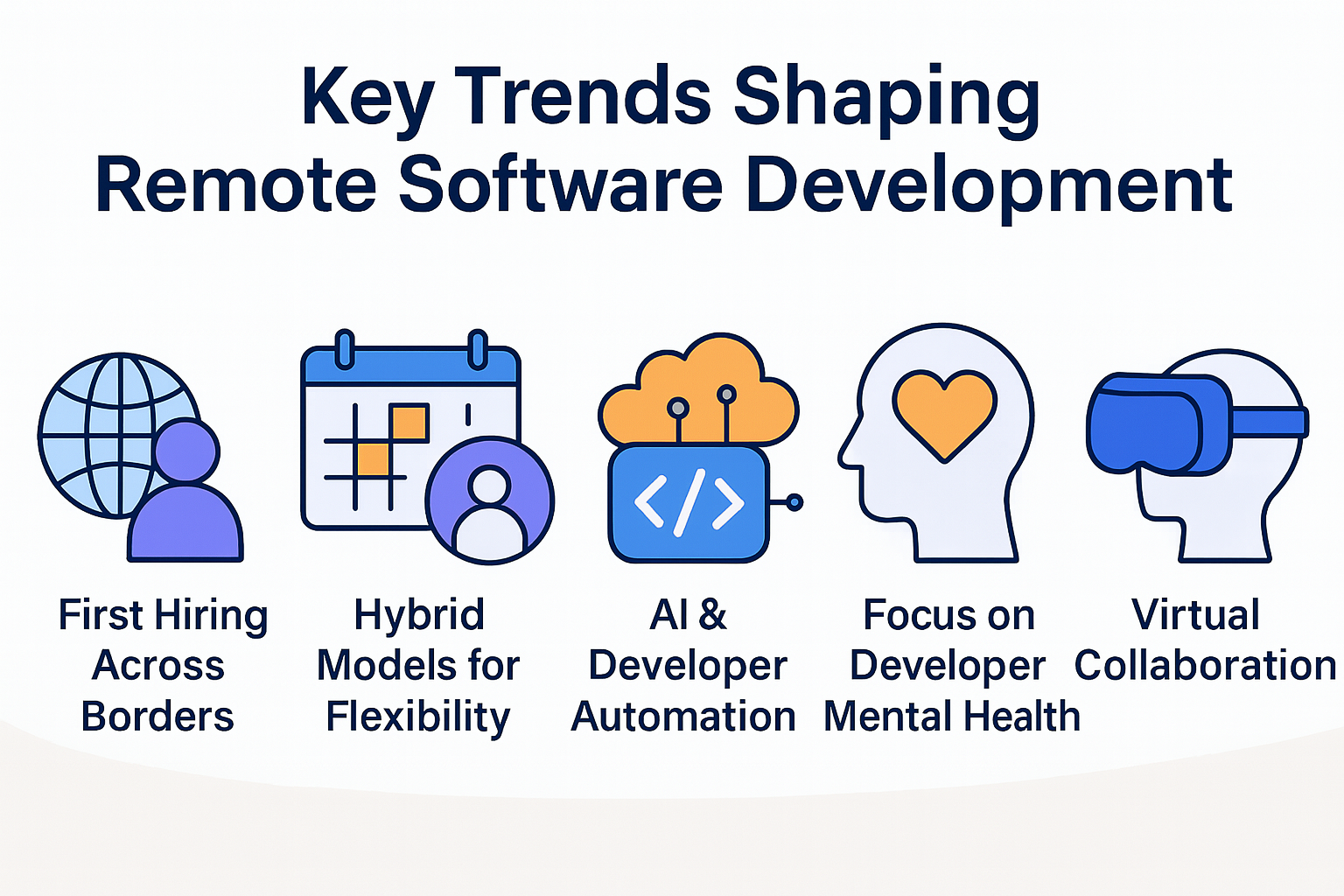
Top Remote Developer Tools & Trends in 2025
Learn the essential tools, trends, and strategies every remote developer needs to thrive in 2025. Master cloud workflows, async collaboration, global teamwork, and AI-powered coding tools.
The global shift to remote work has transformed every industry but few as dramatically as IT. Developers are now building, collaborating, and scaling products entirely from remote environments. As the landscape continues to evolve, staying ahead requires the right tools, habits, and mindset.
In this blog, we explore the top tools remote developers need and the emerging trends that will define remote engineering in 2025 and beyond.

Remote Work in IT: The New Norm
The IT industry was one of the earliest to embrace flexible work models. But after the COVID-19 pandemic, remote work shifted from being an option to becoming standard.
Recent studies show that over 70% of developers prefer remote roles, and many now prioritize flexibility over salary. As more companies adopt remote-first or hybrid models, developers face new challenges and new freedoms from staying connected across time zones to working with distributed teams.
Best Tools for Remote Developers in 2025
Remote success depends heavily on the right tech stack. Below are essential categories and tools to support productivity, collaboration, and security.
1. Developer Collaboration Tools
Real-time and asynchronous communication is crucial. Tools like:
- Slack – for chat and team channels
- Zoom – for meetings and standups
- Loom – for async video walkthroughs
These platforms help reduce meetings and improve async workflows.
2. Code Collaboration & Version Control
Cloud-based Git platforms are the backbone of remote development:
- GitHub and GitLab for version control, code review, and CI/CD
- Bitbucket for tighter Jira integrations
These allow seamless collaboration regardless of location.
3. Cloud IDEs and Remote Dev Environments
Eliminate local machine limitations:
- Gitpod
- AWS Cloud9
- Replit
These enable developers to spin up environments instantly, scale easily, and code from anywhere.
4. Project & Task Management
Keeping remote teams aligned requires visibility and structure:
- Jira – for agile development and sprint tracking
- Asana or Trello for task boards and cross-team collaboration
5. Security Essentials for Remote Coding
Security becomes more critical in distributed setups:
- VPNs and MFA tools (e.g., Authy, Google Authenticator)
- 1Password and LastPass for secure credential management
- Zero Trust access protocols for enterprise-level safety

Key Trends Shaping Remote Software Development
Looking ahead, several trends are defining the future of remote developer work.
1. Remote First Hiring Across Borders
Companies are now building remote teams across continents. Developers no longer need to relocate to work for global brands.
This trend enables:
- Access to global opportunities
- Diverse teams
- Competitive salaries in local economies
2. Hybrid Models for Flexibility
While many love fully remote setups, hybrid models are rising offering:
- Optional office days
- Team retreats for bonding
- Local coworking memberships
3. AI & Developer Automation
Tools like:
- GitHub Copilot
- Tabnine
- Codeium
are helping developers write code faster, reduce bugs, and even auto-generate documentation.
4. Focus on Developer Mental Health
Burnout is a real threat. Remote-friendly companies are now prioritizing:
- Async work hours
- Mental health days
- Deep work over meetings
5. Virtual Reality in Remote Collaboration
Platforms like Spatial and Gather are experimenting with VR for dev teams—enabling immersive standups and creative sessions that mimic office whiteboards.
How Developers Can Succeed in Remote Roles
To thrive in a fully remote setup, developers need to intentionally structure their routines and environments.
Create a Focused Remote Workspace
- Use ergonomic furniture
- Minimize distractions
- Invest in high-speed internet and dual monitors
Stay Connected and Engaged
- Join daily/weekly team calls
- Use async tools to share progress
- Give and request feedback often
Upskill Regularly
Remote devs must stay current. Try:
- Platforms like Coursera, Udemy, or Scrimba
- Dev community newsletters and podcasts
- Open source contributions
Set Boundaries
Avoid burnout by:
- Defining clear working hours
- Taking real breaks
- Logging off at the end of the day

Remote Work Is the Future of IT
Remote work in IT is here to stay and it’s evolving fast. The most successful developers will be those who adopt the right tools, embrace global collaboration, and invest in their skills and well-being.
At Loxala, we connect top-tier developers with remote opportunities across the globe.
Explore freelance IT jobs or hire remote developers on Loxala.
Ready to make your designs accessible and inclusive?
Join Loxala to connect with clients who value inclusivity and create impactful digital experiences.
Start Using Skill Matcher for Free – Find Your Job Easily!
Simplify your job search with Skill Matcher. Whether you're hiring or looking for work, our tool makes the process seamless and fast.

How freelancers can expand their offerings by providing value-added business consulting services. Learn to position yourself as a strategic advisor, deepen client relationships, and unlock new revenue opportunities.
.svg)